The 1941-42 journals of Mrs Ellen Humphreys, grazier of "Hutton Park"
By JOL Admin | 9 May 2019
Guest blogger - Debbie Terranova - Q ANZAC 100 Fellow.
Ellen Maria Humphreys owned and operated a cattle property called “Hutton Park”, situated in the central-west of Queensland near Injune. In 1941, she was a 63-year-old widow with six adult children, several grandchildren, an elderly mother, and a working dog called Tigar.
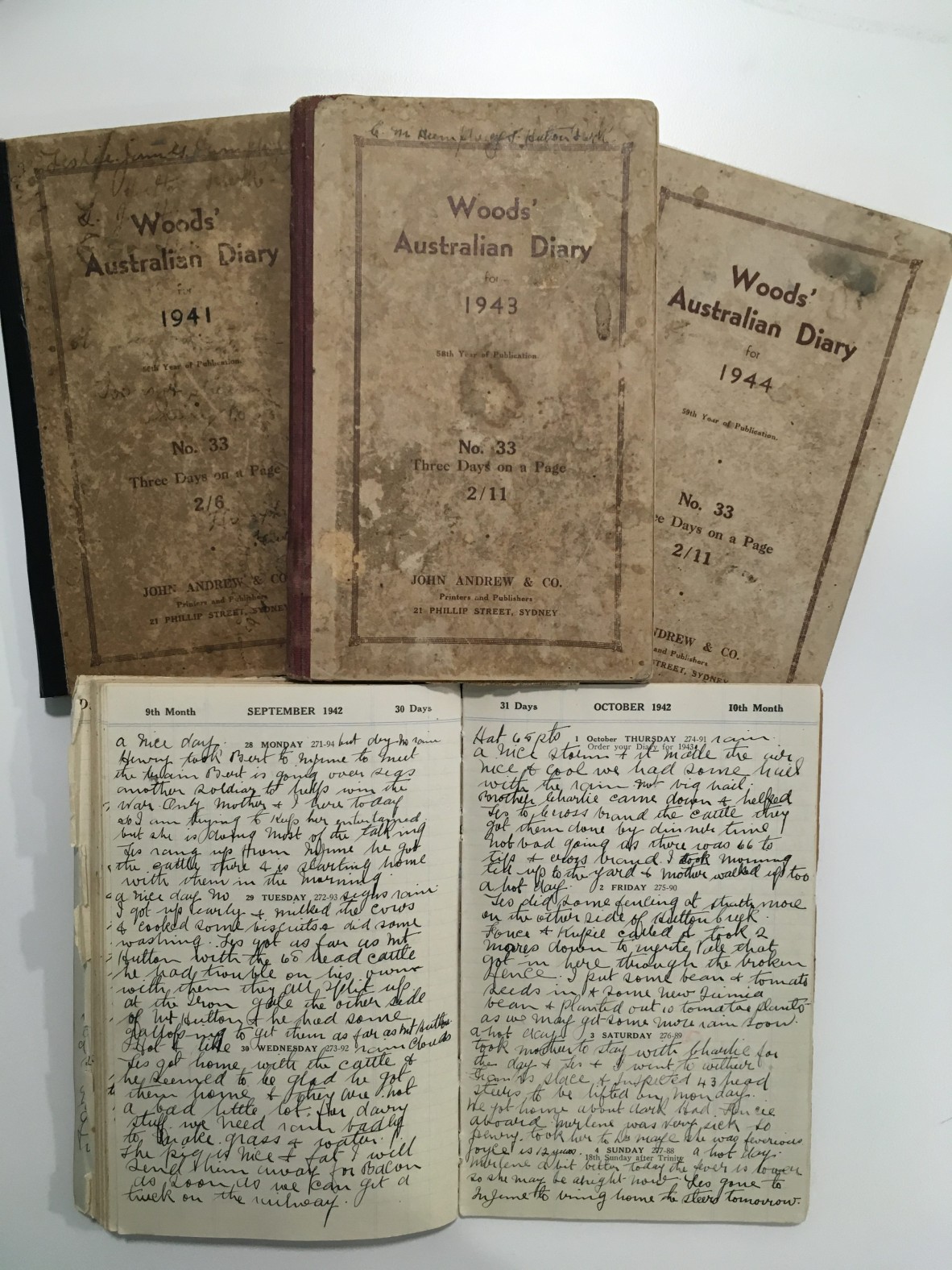
Les, the youngest, was the only one living at home. At 23 years of age, he did all the heavy farm work, such as fencing, ring-barking, chipping suckers, and droving the steers to the sale yards. All of his siblings were married with children. Fred, the eldest, had his own “selection” in the district. Bill and Ellie lived with their respective in-laws on nearby properties, while Daisy and Elsie had moved to Queensland’s south coast.
Each day of the war and for many years beyond, indeed right up until the 1960s, Ellen wrote journal entries about life on her “selection”. In her journals she recorded weather conditions and rainfall, daily activities on the property, headlines about the war, stock numbers and sales, events that affected her family, neighbours, and friends. Her writing was straightforward and matter-of-fact, exactly what you’d expect of a hardworking woman of the bush. Isolated, she was not. She spoke with her daughters on the telephone, caught lifts into town, corresponded by mail. Most weeks, people she knew came to stay, or she visited other farms about the district, often to help when help was needed.
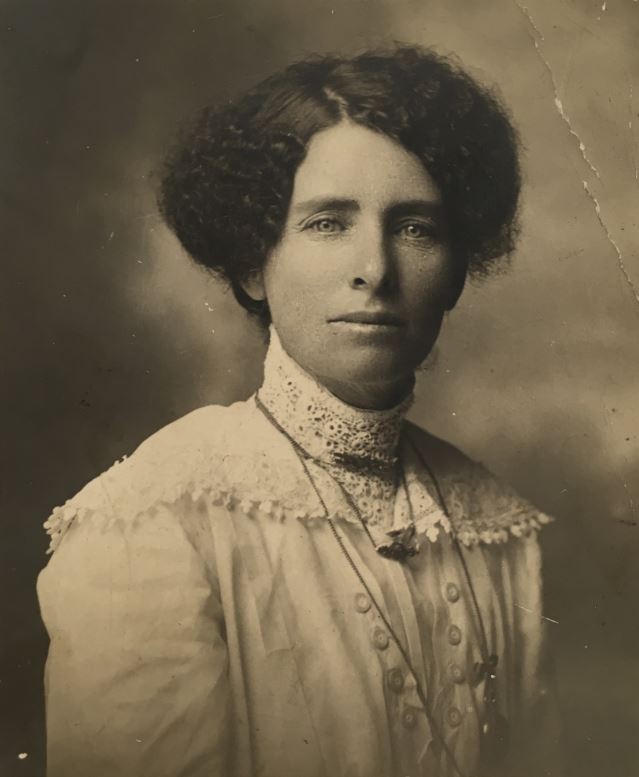
On 21 May 1941, Ellen arranged for a neighbour to drive her to Injune. The main purpose of the trip was to help out a pregnant friend, who had gone to hospital in Roma to prepare for the birth.
As usual, a visit to town was action-packed. While there, she cleaned out her friend’s shed for a race meet, attended a birthday dinner for her 86-year-old mother, and cut sandwiches for the farewell party of a young soldier going to the battlefields of Europe. At the bottom of the journal page, scribbled in haste, was one last entry. “Elsie’s baby born today. Wilfred Gary, they named him.” Thus she recorded the arrival of her newest grandson.
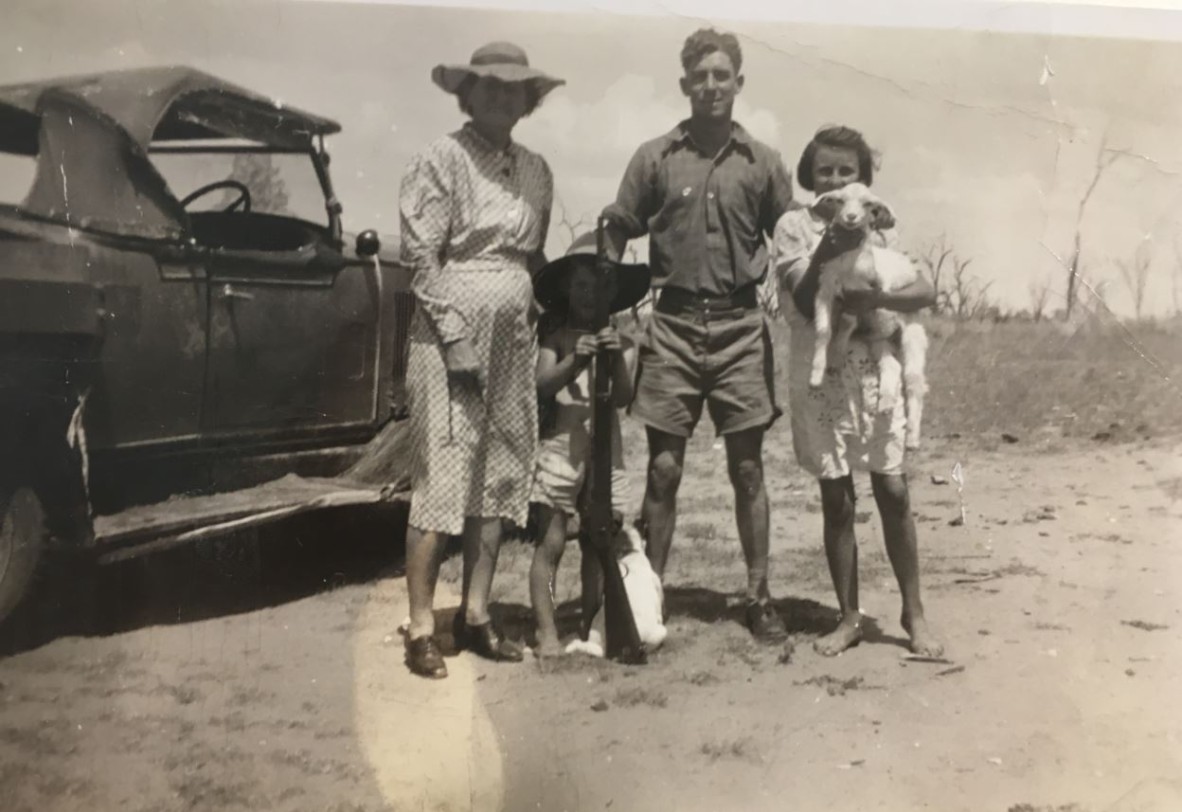
Back at “Hutton Park” a week later, Ellen made journal entries about the war. “The battleship Hood was sunk by the Germans in the ocean. A terrible loss to Britain. The war is awful …I heard R.G. Menzies’ speech tonight. He is home after four months overseas. His speech was great to hear.”
The next day it was “cold and cloudy, misty, little rain during the night. Britain sunk the big German battleship Bismarck so that is good, as the British ship Hood was sunk by the Germans.”
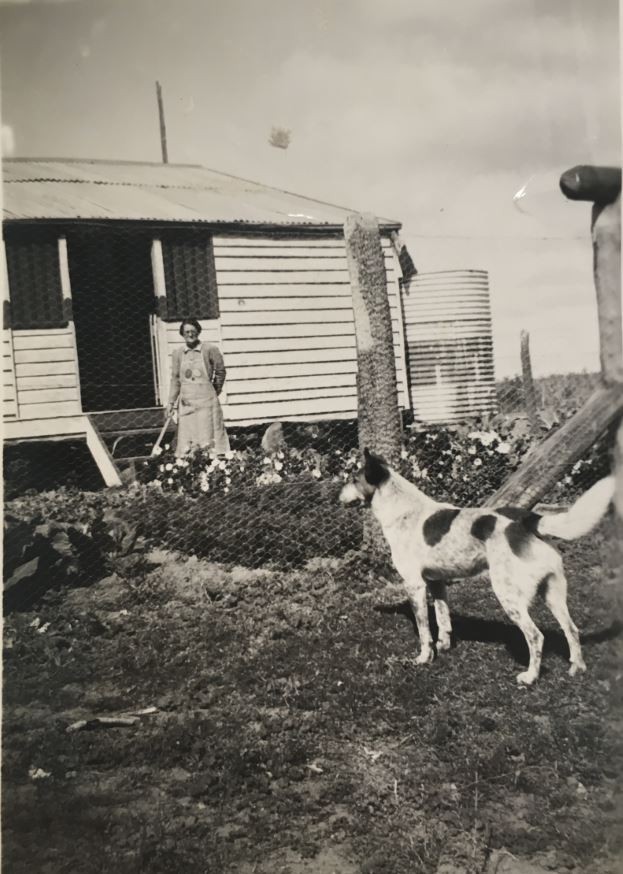
After a long stretch of hot dry weather, much-needed rain arrived in January 1942. Ellen wrote that the grass was growing and looked nice and green. “Got the cows to milk again. Put in eight calfs and four are going to separate in the morning. I saw two hungry dingoes close to the house and took off. Could not get a shot at them so we set out dingo baits.” On 22 January, “The Japs has bombed Singapore and the war is not so good for us.”
At the cattle sale in February they “sold 14 head. Heifers at £4-2-61. Did not sell the steers. They were not fat enough to sell. Fat cattle brought a high price. Les and Joe’s bullocks raised £12-2-62 and cows £9-17-63.” While in Injune, she received word that “four of Mrs Smeeton’s children … are coming out to safety in case the Japs bomb Brisbane.”
16 February 1942. “Singapore has fallen into the Japs’ hands, a sad blow to our country and people. Australia is now in danger.” Other entries of the day mentioned carting “ant bed4 to the dairy for the floor and some manure for the garden vegetables”. Ellen also washed clothes and baked bread.
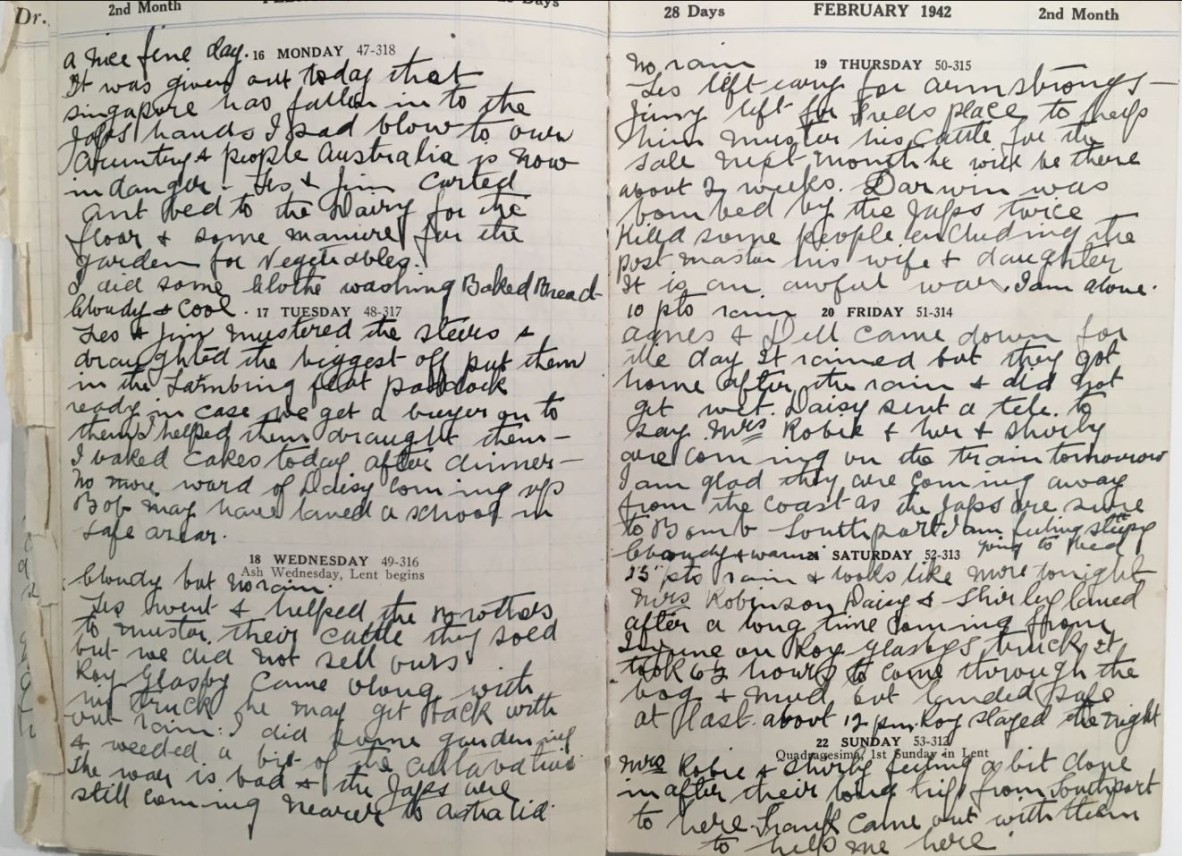
Despite the war, the operation of the farm did not alter much
and daily chores continued as usual. Les went away to muster cattle. Alone on the property, Ellen heard news on the wireless that “Darwin was bombed by the Japs twice. Killed some people including the postmaster, his wife and daughter. It is an awful war.” Later she received a telegram from daughter Daisy to say that she and two friends - Mrs Robie and Shirley - would be on the next train to Injune. “I am glad they are coming away from the coast as the Japs are sure to bomb Southport.”
Heavy rain swept in overnight and the trio arrived on Roy Glasby’s truck. “It took six and a half hours to come through the bog and mud but landed safe at last about 12 . Roy stayed the night.”
The visitors from Southport were in for a bit of bush excitement. “A big brown snake came onto the tank and came close to Mrs Robie, who called out to me, and I shot him in the stomach. But he ran away and the dog, Tigar, killed him.”
The dog came to the rescue again when Ellen “went to pull a pumpkin in the cultivation and Tigar killed a brown snake that was just inside the gate. Only for Tigar, I may have been bitten.”
The visitors left at the end of March. Thankfully the Japanese never bombed Southport.
Early in the winter of 1942, frosts blanketed the paddocks. Graziers and stockmen, droving their cattle, stopped by for a cuppa and sometimes stayed overnight. There was seldom a shortage of passers-by and drop-ins to keep Ellen company.
“Fred5 came along with 65 head steers and six horses. Stayed the night. Put the cattle in the yard as he wants to get an early start in the morning. He is taking them to his place. They are the rejects he could not sell at the last sale Injune. There has been cattle ticks found on the cattle at Injune so a dip has to be made there and all cattle has to be dipped before being sold there.”
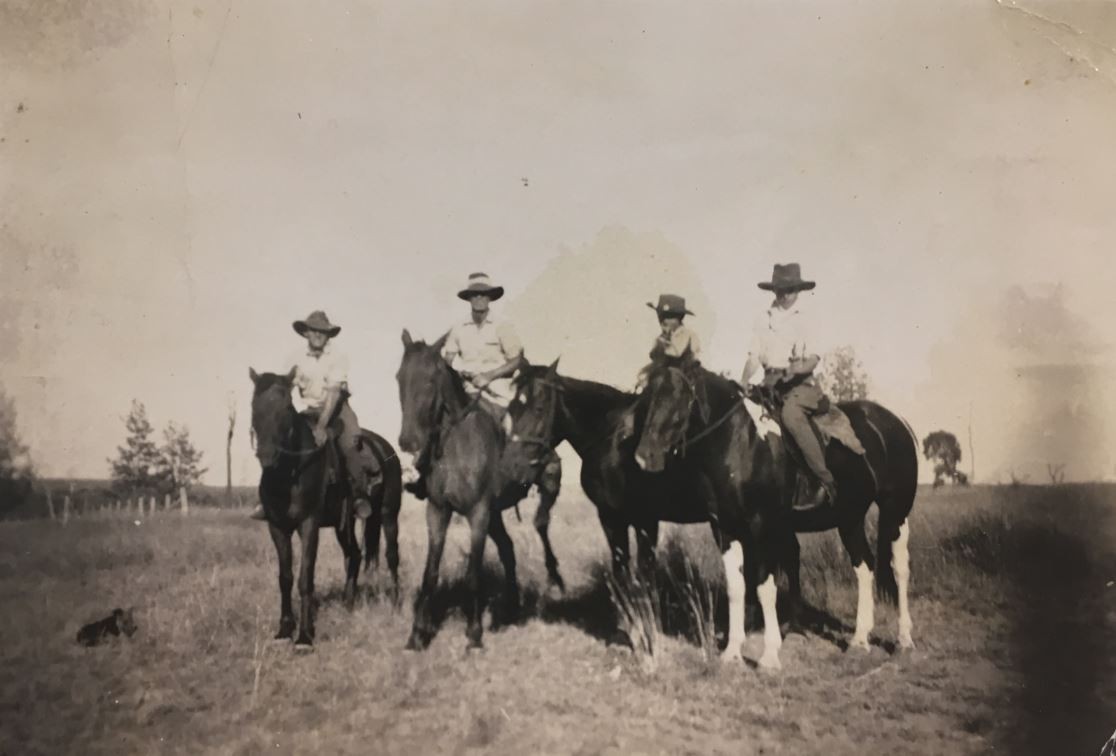
In June 1942, rationing was introduced. “Les went to Mt Hutton and got his and my ration book.” Ellen noted that she “did some mending and darning of clothes as we have to make them last since the Ration came in.” She extended her thrift to making house-wear from offcuts and hessian. “I made myself two work aprons out of two sugar bags and trimmed them with bright material and they look nice and tidy.”
The progress of the war was also concerning her. On 18 June she wrote, “Darwin bombed four days running. Can’t be anything left of Darwin and overseas is not good. Hardly holding their own in China and the Japs seem to take what they want.”
On 24 June 1942, Les cut his finger with an axe. It was a serious cut, right down to the bone on the first joint of his left forefinger. He drove himself into Injune where the nurse stitched it up. Within a short while he was back at work. On 29 June, Ellen recorded that “Les shot two kangaroos. Had a job to skin them with one hand. His left finger is still got the stitches in.” His finger became worse and the pain was intense. In order to see a doctor, he got a lift with a neighbour to Injune and then caught the train to Roma. He phoned Ellen to say “he thinks they may make a job of his finger.” Whatever procedure was done in the hospital, the finger was saved. Les returned, riding a borrowed horse.
To “do his bit” for the war, Les joined the Volunteer Defence Corps6. He passed the medical and was issued a “hat, rifle and coat”. Every week he would travel to Injune to attend training.
The weather turned colder and the water froze in the pipes. Ellen sent her daughter Elsie, who lived on the coast, “five marsupial skins for her air raid shelter.”
Meanwhile Ellen’s elderly mother had become ill and needed care. The plan was to share her around the family, each taking her in for a few months. Ellen was second on the list. A sale of furniture and chattels was held in Injune, but it was not particularly successful.
Mother, along with her furniture, arrived at “Hutton Park” in August and was installed in the front room. It seemed that Mother liked to talk and knit, possibly because her mobility was restricted. Ellen wrote, “I made four pillowslips by hand as I have no machine and it puts my time in as I can’t go out on account of Mother.” Instead, Ellen busied herself about the house and home yard. She hatched “ten nice turkey chicks and the foxes took them all in one night.” Tigar killed two more snakes.
Months passed. With an unheard sigh of relief Ellen wrote, “Mother went to Henry’s place today.”
Mother - Mrs Maria Elizabeth Jackson - passed away two years later at the age of 88. Known as “the grand old woman of the west”, she was survived by 8 children, 40 grandchildren, 56 great-grandchildren, and 2 great-great-grandchildren.
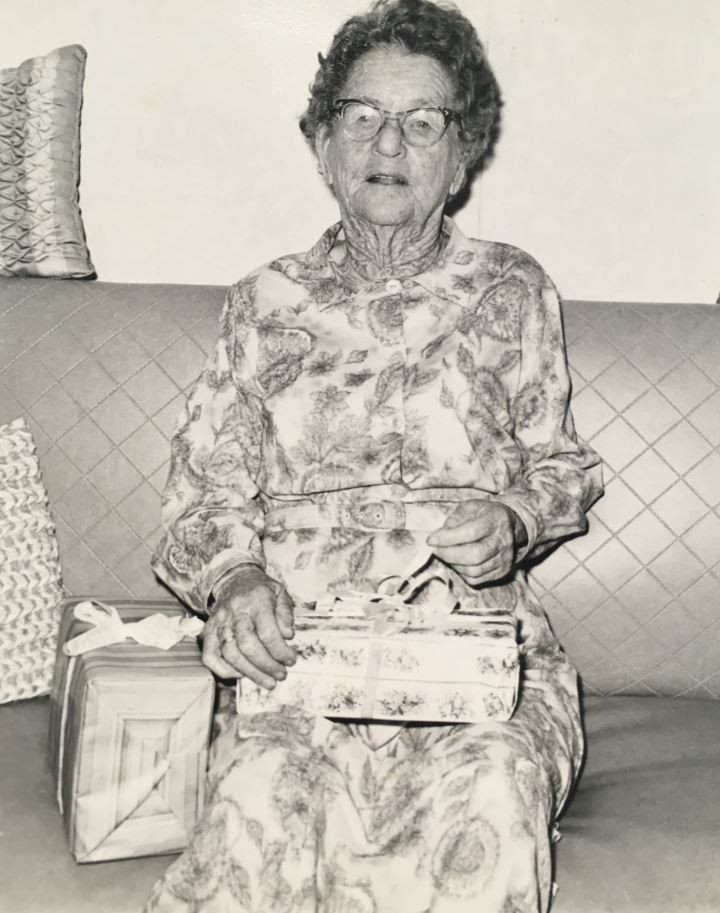
Life at “Hutton Park” continued and Les took over the running of the farm. In old age, Ellen moved to the close-knit community of Injune. She died in 1970 at the age of 93. Her journals open a window to a life of hard work, resilience, and community cohesion that is little known to city dwellers today. Her journals can be viewed at the State Library of Queensland.
Debbie Terranova has a QANZAC 100: Memories for a New Generation Fellowship for 2018-19. Her research project is Queensland women and war: a multicultural perspective of the experiences of female civilians during World War Two.
1 £4-2-6 Sterling is $8.25 in Australian dollars.
2 £12-2-6 is $24.25.
3 £9-17-6 is $19.75.
4 Ant bed, a fine earthen gravel made of crushed termite mounds, was used as a floor base and tennis court surface.
5 Ellen’s eldest son.
6 As a cattleman, which was considered an essential occupation, Les would have been exempt from compulsory military service during the war.
Heritage Leaders Workshop
Are you an employee or volunteer working in the galleries, libraries, archives or museums sectors? Join us for a free two-day workshop reflecting on the outcomes of Queensland's Anzac Centenary commemorations on 30-31 May 2019. Bookings essential.
Comments
Your email address will not be published.
We welcome relevant, respectful comments.